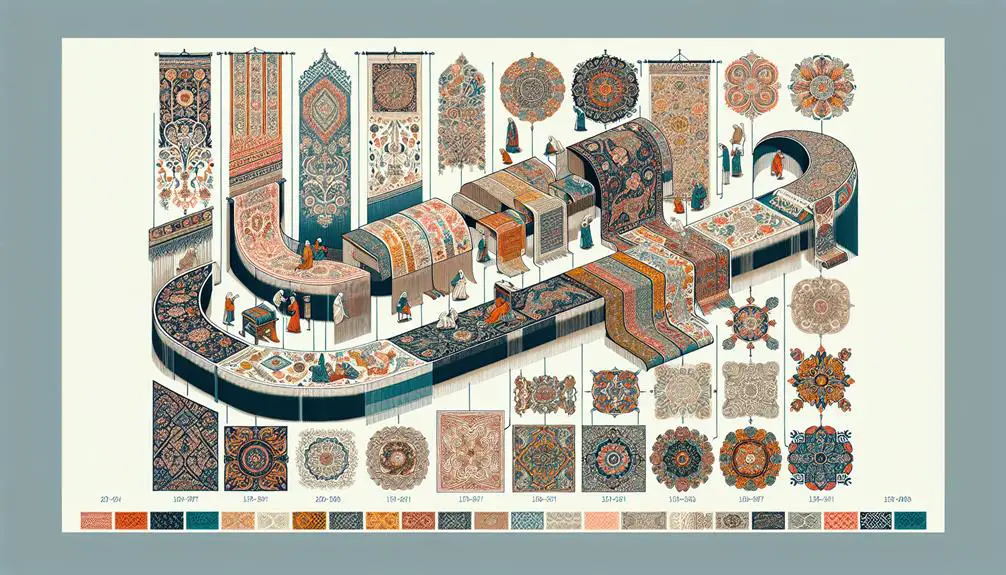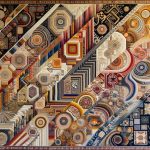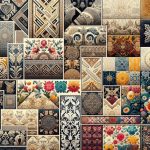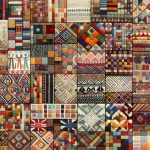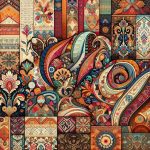You see it in ancient Egyptian hieroglyphics, Greek and Roman textiles, and medieval European designs; the development of textile patterns is a journey through cultural history. Each era's patterns reveal much about the social status, artistic innovations, and technological advancements of the time. Imagine Islamic geometric patterns intersecting with Asian textile traditions, or African tribal motifs weaving through the Renaissance and Industrial Revolution. These progressions offer a glimpse into how societies have communicated identity and aesthetics through fabric. So, how did these patterns evolve and what do they tell us about the people who created them?
Table of Contents
Key Takeaways
- Ancient Egyptian patterns featured geometric shapes and symbolic motifs inspired by hieroglyphics.
- Islamic and Asian textile traditions showcased intricate designs and precise mathematical foundations.
- African tribal motifs conveyed cultural significance and historical narratives with vibrant symbols.
- Renaissance innovations introduced complex narratives and advanced dyeing techniques.
- Modern patterns blend traditional motifs with minimalist designs and sustainable, eco-friendly fabrics.
Ancient Egyptian Patterns
Ancient Egyptian patterns often featured intricate geometric shapes and symbolic motifs that reflected their rich cultural heritage. You can see this in the way they used hieroglyphic inspirations to create designs that weren't just visually appealing but also carried deep meanings.
Each symbol and geometric shape in their patterns was carefully chosen, often representing gods, nature, or aspects of daily life. These patterns adorned everything from the walls of tombs to the garments worn by royalty.
Pharaoh fashion was a prime example of how these patterns were utilized. The clothing of the pharaohs wasn't merely for covering the body; it was a statement of power, divinity, and culture. The textiles used were often adorned with complex patterns that included hieroglyphic symbols and geometric shapes, making the garments not only majestic but also narratively rich.
You'd find lotus flowers, scarabs, and the ankh symbol frequently appearing in these designs, each adding layers of meaning and significance. Understanding these patterns allows you to appreciate the sophistication and intentionality behind ancient Egyptian textiles, giving you a deeper insight into their world and the legacy they've left behind.
Greek and Roman Textiles
Greek and Roman textiles, known for their intricate designs and vibrant colors, played a pivotal role in expressing social status and cultural identity. You'll find that these textiles weren't merely functional but also rich in symbolism.
Greek textiles often mirrored the geometric patterns and mythological themes seen in Greek pottery. Imagine the elegance of a peplos adorned with meandering lines, spirals, and stylized floral motifs, much like the decorations on ancient amphorae.
Roman textiles, on the other hand, exhibited a blend of local traditions and influences from conquered territories. These textiles frequently reflected the detailed artistry found in Roman mosaics. Picture togas and tunics embellished with intricate borders and medallions, capturing the essence of Roman sophistication. The use of purple dye, extracted from the murex snail, was particularly significant, denoting imperial status and wealth.
Understanding these textiles gives you insight into the ancient world's social hierarchies and artistic achievements. The finesse in weaving techniques and the complexity of patterns reveal a society that valued both form and function. By studying Greek and Roman textiles, you're not just learning about cloth; you're delving into a rich tapestry of history and culture.
Medieval European Designs
Moving from the classical elegance of Greek and Roman textiles, you'll find that Medieval European designs brought a new level of complexity and symbolism to the art of weaving. In this period, medieval tapestries became monumental works of art, often depicting elaborate scenes of chivalry, mythology, and biblical stories. These tapestries weren't just for decoration; they also served as insulation in drafty castles and were symbols of wealth and power.
When you explore medieval fashion, you'll notice an abundance of decorative embellishments. Garments were adorned with intricate patterns, and royal embroidery reached new heights of sophistication. Nobles and royalty commissioned garments that showcased their status, using gold thread, pearls, and precious stones to create opulent designs.
The symbolism in these textiles was profound. Each motif, from the lion to the fleur-de-lis, carried specific meanings, reflecting the wearer's identity and values. The craftsmanship required for such detailed work was immense, often taking years to complete a single piece.
Islamic Geometric Patterns
The intricate beauty of Islamic geometric patterns lies in their precise mathematical foundations and profound spiritual symbolism.
You'll find that these designs are far from arbitrary; they emerge from a meticulous process of geometric symmetry and intricate details. By mastering these patterns, you're not just learning an art form but also engaging with centuries of cultural symbolism and artistic expression.
To create these patterns, artisans use a compass and straightedge to draft complex shapes like stars, polygons, and interlaced motifs. The repeated use of circles, squares, and other geometric forms manifests a unity that reflects the infinite nature of the universe.
Each pattern, though infinitely repeatable, maintains a perfect balance and harmony, giving you a sense of order and tranquility.
In Islamic art, these patterns are more than decorative elements; they serve as a conduit for spiritual contemplation. The geometric symmetry and intricate details are designed to lead your mind to higher states of awareness.
As you explore further into these patterns, you're participating in a rich tradition that merges mathematics, art, and spirituality into a cohesive whole. Such mastery transforms mere fabric into a canvas of profound significance.
Asian Textile Traditions
When exploring Asian textile traditions, you'll notice the profound influence of the ancient Silk Road, which facilitated cultural exchange and innovation.
Traditional dyeing techniques, such as Japan's Shibori and India's Bandhani, showcase the region's craftsmanship.
Additionally, the intricate symbolism in fabric patterns often tells stories of heritage, beliefs, and social status.
Ancient Silk Road Influence
Imagine the vibrant patterns and rich textures that traveled along the ancient Silk Road, shaping Asian textile traditions in profound ways. Through Silk Road trade, you witnessed a remarkable cultural exchange that brought together diverse aesthetics and craftsmanship. Intricate designs from Persia, India, and China intermingled, creating a tapestry of shared artistic heritage.
You'd see floral motifs, mythical creatures, and geometric patterns blending seamlessly, each reflecting the unique identity of its origin while embracing new influences.
As you explore these textiles, you'll notice the exquisite silk fabrics that revolutionized fashion and interior decor across continents. Silk, prized for its luster and durability, became a symbol of wealth and sophistication. The methods of weaving and embellishing these textiles evolved, incorporating techniques from different regions.
This fusion of skills and styles enriched the cultural fabric of Asia, making its textiles some of the most sought-after commodities in the ancient world.
The Silk Road wasn't just a trade route; it was a conduit for artistic innovation and cross-cultural fertilization. By examining these textiles, you gain insight into how interconnected the ancient world was, and how its legacy continues to influence modern textile design.
Traditional Dyeing Techniques
You can see the rich history and vibrant artistry of Asian textile traditions come alive through their traditional dyeing techniques. Mastering these methods means delving into centuries-old practices that have shaped the aesthetics of cultures from Japan to India.
For instance, the recent tie dye revival has spotlighted the intricate Japanese shibori technique, where fabrics are meticulously folded, twisted, or bound before dyeing. This method creates stunning, resist-dyed patterns that are both delicate and bold.
Natural indigo techniques are another cornerstone of Asian textile dyeing. In places like India, the dye is derived from the indigofera plant, which has been used for millennia. The process of fermenting the plant to extract the dye is both a science and an art, requiring precise timing and environmental conditions. The fabric is dipped repeatedly, each time emerging a deeper shade of blue.
This technique not only produces rich, lasting colors but also connects you to a lineage of artisans who've perfected this craft over generations.
Symbolism in Fabric Patterns
Across Asia, fabric patterns are deeply infused with symbolism, often reflecting cultural beliefs, historical events, and social status. When you explore these textiles, you'll find that every motif, color, and composition serves as a conduit of cultural symbolism and artistic expression.
For instance, in Chinese textiles, the dragon symbolizes power and authority, while the phoenix represents rebirth and immortality.
In Japan, you'll notice the chrysanthemum, a symbol of the imperial family, frequently adorning kimonos. These patterns aren't just decorative; they're steeped in historical significance, conveying stories and traditions passed down through generations.
As you investigate the design evolution of Indian textiles, you'll encounter intricate paisley and floral motifs. These patterns, initially emblematic of fertility and prosperity, have transcended their origins to become globally recognized symbols of elegance.
Exploring Southeast Asian batik, you'll appreciate how patterns like the parang, once reserved for royalty, embody the region's rich heritage and artistic ingenuity.
African Tribal Motifs
Delving into African tribal motifs reveals a rich tapestry of symbols and patterns that convey deep cultural significance and historical narratives. When you explore these textiles, you'll notice the vibrant color symbolism that defines each piece. Colors aren't just aesthetic choices; they hold profound meanings. For instance, red often symbolizes strength and unity, while black can represent ancestral spirits and the unknown. Understanding these colors allows you to appreciate the cultural depth embedded in the fabric.
Patterns in African textiles aren't mere decorations; they serve as visual stories. Each motif tells a piece of history or an important cultural value. Adinkra symbols from Ghana, for example, communicate wisdom, courage, and other virtues. Kuba cloth from the Democratic Republic of Congo showcases geometric patterns that signify social status and community roles. By studying these patterns, you gain insights into the tribe's beliefs and societal structures.
To master the art of African tribal motifs, focus on both the overt and subtle details. Pay attention to the interplay of colors and symbols. This dual focus will elevate your understanding and appreciation of these intricate designs, enriching your knowledge of textile history.
Renaissance Innovations
Renaissance innovations in textile patterns marked a pivotal era of creativity and technical advancements that forever transformed fabric design. You'll find that this period wasn't just a time of artistic rebirth but also a textile revival, where sumptuous fabrics became a canvas for intricate designs.
Renaissance tapestries, for instance, are exemplary of the era's grandeur, weaving complex narratives and lush landscapes that showcased the artisans' skill and the patrons' wealth.
During this period, Italian brocade reached new heights of pattern intricacy. These opulent fabrics, woven with gold and silver threads, featured elaborate floral and geometric motifs that were meticulously crafted. The designs weren't merely decorative; they signaled social status and power, making them highly coveted among the elite.
Additionally, the Renaissance saw the rise of new dyeing techniques and the introduction of exotic materials like silk, which were imported along burgeoning trade routes. The result was a dazzling array of vibrant textiles that were as innovative as they were beautiful.
As you explore further into Renaissance textiles, you'll appreciate how these innovations laid the groundwork for future advancements in fabric design.
Industrial Revolution Impact
During the Industrial Revolution, there was a significant transformation in textile patterns due to mechanized weaving techniques. This era's machinery enabled mass production, drastically altering how textiles were made and distributed.
As a result, patterns became more uniform and accessible to a broader audience.
Mechanized Weaving Techniques
The Industrial Revolution's mechanized weaving techniques transformed textile production, making fabrics more affordable and accessible. You witnessed a significant shift with the arrival of loom automation, which enabled weavers to produce intricate patterns at unprecedented speeds. This leap forward in technology didn't just streamline production; it also gave rise to a new era of fabric innovation.
To fully appreciate the impact, consider these key advancements:
- Power Looms: These automated looms reduced manual labor, allowing for consistent, high-quality textile output.
- Jacquard Loom: With its punch card system, this loom made it possible to weave complex patterns effortlessly, enabling you to create intricate and varied designs.
- Spinning Jenny: This multi-spindle spinning frame increased yarn production, ensuring that the looms had a steady supply of thread.
- Steam Power: The integration of steam engines into mills enabled round-the-clock operation, drastically increasing production capacity.
Mastering these innovations offered you the ability to produce textiles on a scale never seen before, democratizing access to high-quality fabrics. Understanding these mechanized weaving techniques is essential for anyone aiming to grasp the full scope of textile evolution during the Industrial Revolution.
Mass Production Influence
Witnessing the transformative power of mechanized weaving techniques, you can't ignore how mass production during the Industrial Revolution reshaped the textile industry and society at large. Factory production became the backbone of this new era, enabling unprecedented scale and speed in textile manufacturing. The rapid design evolution that accompanied these changes meant that intricate patterns, once the domain of skilled artisans, could be replicated en masse with remarkable consistency.
Technological advancements like the power loom and the Jacquard loom not only boosted efficiency but also democratized textile access. You could see ornate designs that were previously reserved for the elite now available to the broader public. This shift didn't just alter the market but also influenced social dynamics, as textiles became a symbol of the emerging middle class.
However, with mass production came the challenge of cultural preservation. Traditional weaving techniques and indigenous designs risked being overshadowed by the flood of factory-made textiles. Yet, in many cases, these very technologies were adapted to preserve cultural heritage, blending old motifs with new methods.
This way, the Industrial Revolution catalyzed both the evolution and the preservation of textile patterns, balancing innovation with tradition.
Modern and Contemporary Styles
Modern and contemporary textile patterns often blend traditional motifs with innovative designs to create unique, eye-catching styles. You'll find that minimalist designs and abstract patterns dominate current trends. These styles often favor clean lines and simple color palettes, making them versatile for various applications. Minimalism, with its less-is-more approach, contrasts sharply with the complex, ornate patterns of the past, offering a invigorating simplicity that's both elegant and modern.
Another significant development is the rise of sustainable textiles and eco-friendly fabrics. You're likely aware of the increasing demand for materials that are both beautiful and environmentally responsible. Textiles made from organic cotton, recycled fibers, and even bamboo are becoming mainstream, reflecting a shift towards more conscious consumption.
To truly appreciate modern and contemporary styles, consider these key points:
- Minimalist Designs: Embrace simplicity with clean lines and neutral colors.
- Abstract Patterns: Enjoy the freedom of non-representational art in your textiles.
- Sustainable Textiles: Choose fabrics made from renewable or recycled materials.
- Technological Integration: Look for textiles that incorporate smart fabrics and innovative technologies.
Frequently Asked Questions
How Did Textile Patterns Influence Social Hierarchies in Different Cultures?
How did textile patterns shape social hierarchies in different cultures? You'll see that fashion trends and power dynamics were deeply connected, with cultural symbolism in patterns often indicating social status, reinforcing societal roles and distinctions.
What Role Did Trade Routes Play in the Exchange of Textile Designs?
You'll find that trade routes, especially the Silk Road, played an essential role in the exchange of textile designs. They facilitated cultural exchange, allowing intricate patterns and techniques to spread, enriching local textile traditions globally.
How Have Technological Advancements Impacted Textile Pattern Production?
Have you considered how technological advancements revolutionized textile patterns? Digital printing allows intricate designs with ease, while automated weaving enhances precision and efficiency. Mastering these innovations elevates your craft, making you a leader in textile artistry.
What Are the Environmental Impacts of Traditional Vs. Modern Textile Dyeing Methods?
You should consider that traditional dyeing methods often use natural dyes, which have a lower environmental impact. However, modern techniques, though more efficient, can involve chemicals that affect sustainability negatively. Choose wisely for environmental sustainability.
How Do Textile Patterns Reflect Cultural Identity and Heritage?
You'll find textile patterns rich in cultural representation and historical significance. They showcase unique symbols, colors, and techniques that reflect your heritage, telling stories of your ancestors and preserving traditions that transcend generations.

